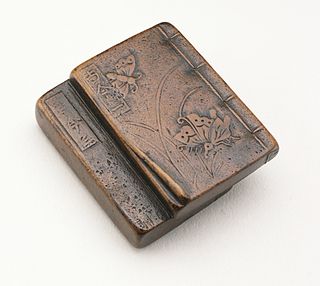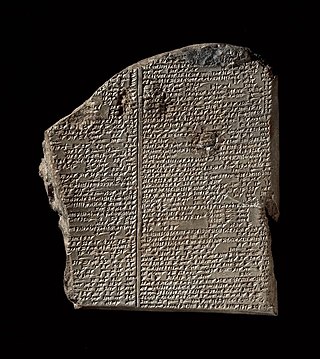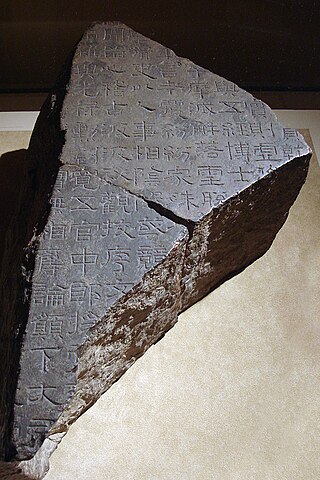Chinese classic texts or canonical texts or simply dianji (典籍) refers to the Chinese texts which originated before the imperial unification by the Qin dynasty in 221 BC, particularly the "Four Books and Five Classics" of the Neo-Confucian tradition, themselves a customary abridgment of the "Thirteen Classics". All of these pre-Qin texts were written in either Old or Classical Chinese. All three canons are collectively known as the Classics.
The Man'yōshū is the oldest extant collection of Japanese waka, compiled sometime after AD 759 during the Nara period. The anthology is one of the most revered of Japan's poetic compilations. The compiler, or the last in a series of compilers, is today widely believed to be Ōtomo no Yakamochi, although numerous other theories have been proposed. The chronologically last datable poem in the collection is from AD 759 (No. 4516). It contains many poems from a much earlier period, with the bulk of the collection representing the period between AD 600 and 759. The precise significance of the title is not known with certainty.

Modern lyric poetry is a formal type of poetry which expresses personal emotions or feelings, typically spoken in the first person.

Chinese poetry is poetry written, spoken, or chanted in the Chinese language, and a part of the Chinese literature. While this last term comprises Classical Chinese, Standard Chinese, Mandarin Chinese, Yue Chinese, and other historical and vernacular forms of the language, its poetry generally falls into one of two primary types, Classical Chinese poetry and Modern Chinese poetry.

Classical Chinese poetry is traditional Chinese poetry written in Classical Chinese and typified by certain traditional forms, or modes; traditional genres; and connections with particular historical periods, such as the poetry of the Tang dynasty. The existence of classical Chinese poetry is documented at least as early as the publication of the Classic of Poetry (Shijing). Various combinations of forms and genres have developed over the ages. Many or most of these poetic forms were developed by the end of the Tang dynasty, in 907 CE.

The Kokin Wakashū, commonly abbreviated as Kokinshū (古今集), is an early anthology of the waka form of Japanese poetry, dating from the Heian period. An imperial anthology, it was conceived by Emperor Uda and published by order of his son Emperor Daigo in about 905. Its finished form dates to c. 920, though according to several historical accounts the last poem was added to the collection in 914.

The Classic of Poetry, also Shijing or Shih-ching, translated variously as the Book of Songs, Book of Odes, or simply known as the Odes or Poetry, is the oldest existing collection of Chinese poetry, comprising 305 works dating from the 11th to 7th centuries BC. It is one of the "Five Classics" traditionally said to have been compiled by Confucius, and has been studied and memorized by scholars in China and neighboring countries over two millennia. It is also a rich source of chengyu that are still a part of learned discourse and even everyday language in modern Chinese. Since the Qing dynasty, its rhyme patterns have also been analysed in the study of Old Chinese phonology.

Shi and shih are romanizations of the character 詩/诗, the Chinese word for all poetry generally and across all languages.
Chinese folklore encompasses the folklore of China, and includes songs, poetry, dances, puppetry, and tales. It often tells stories of human nature, historical or legendary events, love, and the supernatural. The stories often explain natural phenomena and distinctive landmarks. Along with Chinese mythology, it forms an important element in Chinese folk religion.

Japanese poetry is poetry typical of Japan, or written, spoken, or chanted in the Japanese language, which includes Old Japanese, Early Middle Japanese, Late Middle Japanese, and Modern Japanese, as well as poetry in Japan which was written in the Chinese language or ryūka from the Okinawa Islands: it is possible to make a more accurate distinction between Japanese poetry written in Japan or by Japanese people in other languages versus that written in the Japanese language by speaking of Japanese-language poetry. Much of the literary record of Japanese poetry begins when Japanese poets encountered Chinese poetry during the Tang dynasty. Under the influence of the Chinese poets of this era Japanese began to compose poetry in Chinese kanshi); and, as part of this tradition, poetry in Japan tended to be intimately associated with pictorial painting, partly because of the influence of Chinese arts, and the tradition of the use of ink and brush for both writing and drawing. It took several hundred years to digest the foreign impact and make it an integral part of Japanese culture and to merge this kanshi poetry into a Japanese language literary tradition, and then later to develop the diversity of unique poetic forms of native poetry, such as waka, haikai, and other more Japanese poetic specialties. For example, in the Tale of Genji both kanshi and waka are frequently mentioned. The history of Japanese poetry goes from an early semi-historical/mythological phase, through the early Old Japanese literature inclusions, just before the Nara period, the Nara period itself, the Heian period, the Kamakura period, and so on, up through the poetically important Edo period and modern times; however, the history of poetry often is different from socio-political history.

The Chu Ci, variously translated as Verses of Chu, Songs of Chu, or Elegies of Chu, is an ancient anthology of Chinese poetry including works traditionally attributed mainly to Qu Yuan and Song Yu from the Warring States period, as well as a large number of works composed during the Han dynasty several centuries later,. The traditional version of the Chu Ci contains 17 major sections, anthologized with its current contents by Wang Yi, a 2nd-century AD librarian who served under Emperor Shun of Han. Classical Chinese poetry prior to the Qin dynasty is largely known through the Chu Ci and the Classic of Poetry.

Poetry as an oral art form likely predates written text. The earliest poetry is believed to have been recited or sung, employed as a way of remembering oral history, genealogy, and law. Poetry is often closely related to musical traditions, and the earliest poetry exists in the form of hymns, and other types of song such as chants. As such, poetry is often a verbal art. Many of the poems surviving from the ancient world are recorded prayers, or stories about religious subject matter, but they also include historical accounts, instructions for everyday activities, love songs, and fiction.
The Three Hundred Tang Poems is an anthology of poems from the Chinese Tang dynasty (618–907). It was first compiled around 1763 by Sun Zhu (1722–1778), who was a Qing Dynasty scholar and was also known as Hengtang Tuishi. Various later editions also exist. All editions contain slightly more than 300 total poems. The number 300 was a classic number for a poetry collection due to the influence of the Classic of Poetry, which was generally known as The Three Hundred Poems.

Classical Chinese poetry forms are poetry forms or modes which typify the traditional Chinese poems written in Literary Chinese or Classical Chinese. Classical Chinese poetry has various characteristic forms, some attested to as early as the publication of the Classic of Poetry, dating from a traditionally, and roughly, estimated time of around 10th–7th century BCE. The term "forms" refers to various formal and technical aspects applied to poems: this includes such poetic characteristics as meter, rhythm, and other considerations such as vocabulary and style. These forms and modes are generally, but not invariably, independent of the Classical Chinese poetry genres. Many or most of these were developed by the time of the Tang Dynasty, and the use and development of Classical Chinese poetry and genres actively continued up until the May Fourth Movement, and still continues even today in the 21st century.

Han poetry as a style of poetry resulted in significant poems which are still preserved today, and whose origins are associated with the Han dynasty era of China, 206 BC – 220 AD, including the Wang Mang interregnum. The final years at the end of the Han era often receive special handling for purposes of literary analysis because, among other things, the poetry and culture of this period is less than typical of the Han period, and has important characteristics of its own, or it shares literary aspects with the subsequent Three Kingdoms period. This poetry reflects one of the poetry world's more important flowerings, as well as being a special period in Classical Chinese poetry, particularly in regard to the development of the quasipoetic fu; the activities of the Music Bureau in connection with the collection of popular ballads and the resultant development of what would eventually become known as the yuefu, or as the rhapsodic formal style; and, finally, towards the end of the Han dynasty, the development of a new style of shi poetry, as the later development of the yuehfu into regular, fixed-line length forms makes it difficult to distinguish in form from the shi form of poetic verse, and at what point specific poems are classified as one or the other is somewhat arbitrary. Another important poetic contribution from the Han era is the compilation of the Chuci anthology, which contains some of the oldest and most important poetic verses to be preserved from ancient China, as well as the transmission of the Shijing anthology.
Sun Zhu (1711–1778) was a Chinese poet and poetry anthologist of the Qing dynasty. He was also known as Hengtang Tuishi and was the original compiler and editor of the anthology Three Hundred Tang Poems, a popular compilation of Tang poetry, partly designed as a study aid for students. An enduring classic, Sun Zhu's version has often been reprinted, often in revised or re-edited editions.

Qing poetry refers to the poetry of or typical of the Qing dynasty (1644–1911). Classical Chinese poetry continued to be the major poetic form of the Qing dynasty, during which the debates, trends and widespread literacy of the Ming period began to flourish once again after a transitional period during which the Qing dynasty had established its dominance. Also, popular versions of Classical Chinese poetry were transmitted through Qing dynasty anthologies, such as the collections of Tang poetry known as the Complete Tang Poems and the Three Hundred Tang Poems. The poetry of the Qing Dynasty has an ongoing and growing body of scholarly literature associated with its study. Both the poetry of the Ming dynasty and the poetry of the Qing dynasty are studied for poetry associated with Chinese opera, the developmental trends of Classical Chinese poetry and the transition to the more vernacular type of Modern Chinese poetry, as well as poetry by women in Chinese culture.

Waka is a type of poetry in classical Japanese literature. Although waka in modern Japanese is written as 和歌, in the past it was also written as 倭歌, and a variant name is yamato-uta (大和歌).
Sunflower Splendor: Three Thousand Years of Chinese Poetry is an anthology of around 1,000 Chinese poems translated into English, edited by Wu-chi Liu and Irving Yucheng Lo and published in 1975 by Anchor Press/Doubleday. Wu-chi Liu served as the anthology's senior editor. As of 2002, the book had been widely used in Asian literature studies. In 2002 Stacy Finz of the San Francisco Chronicle wrote that the book "was a best-seller".